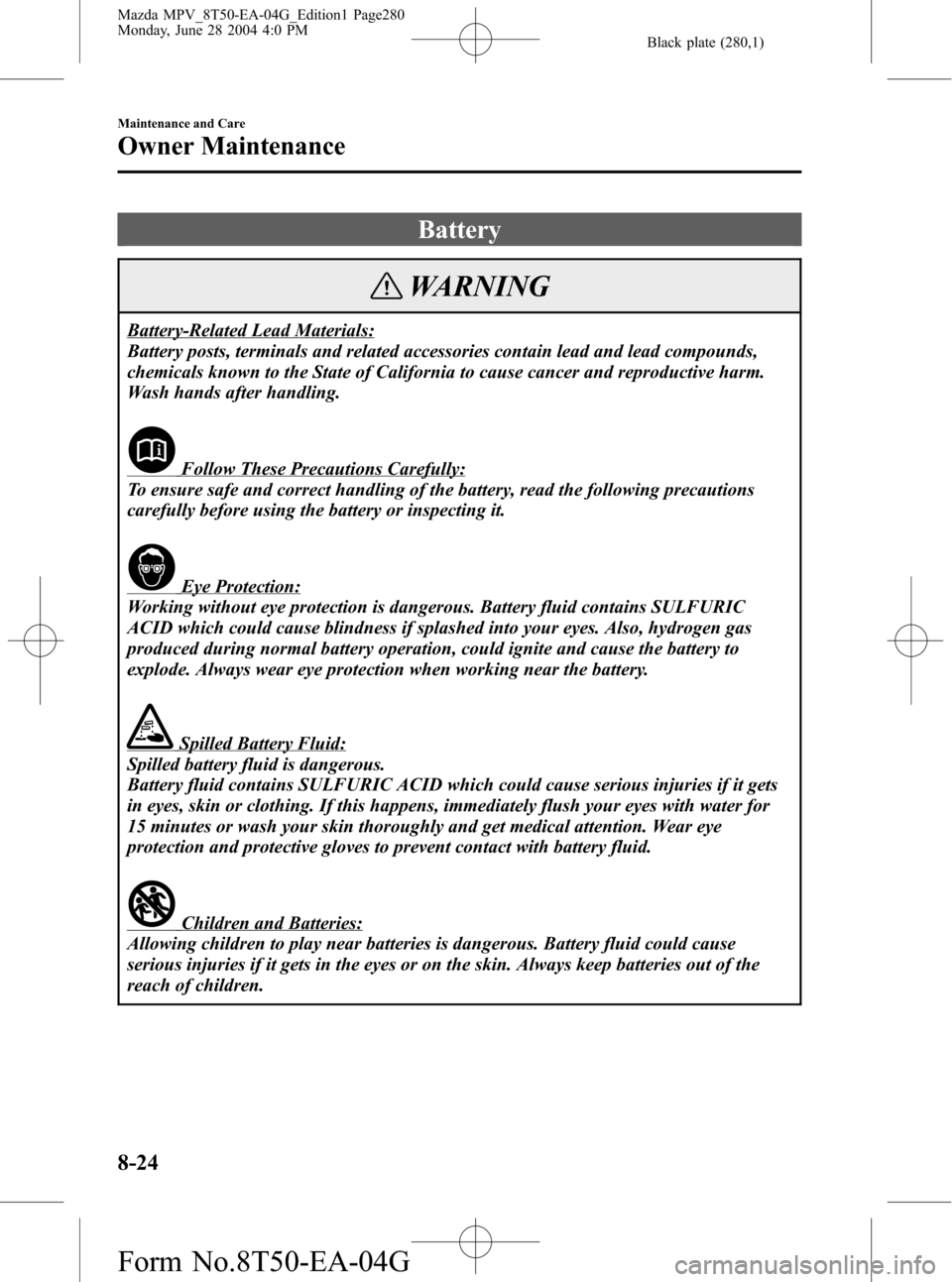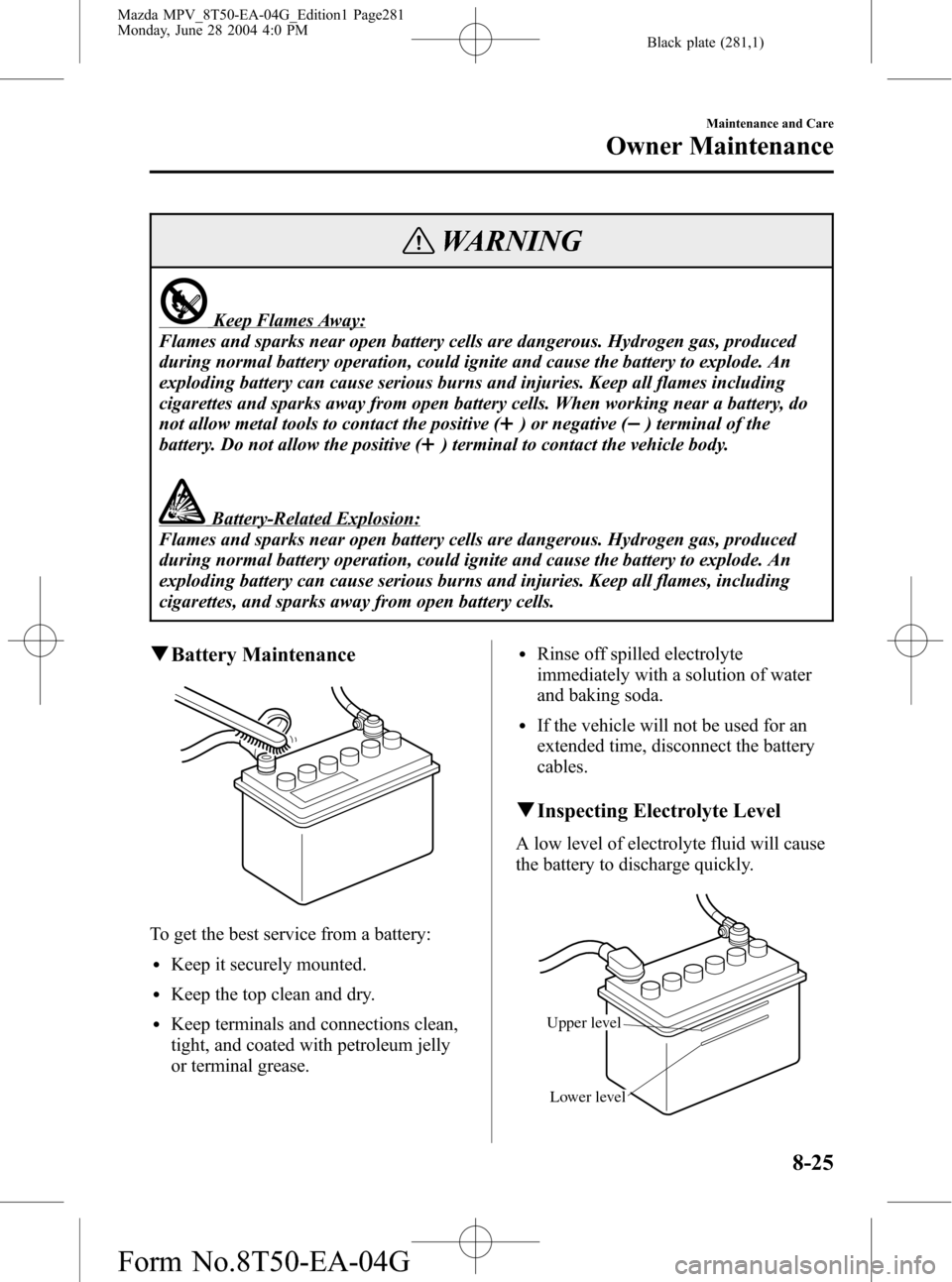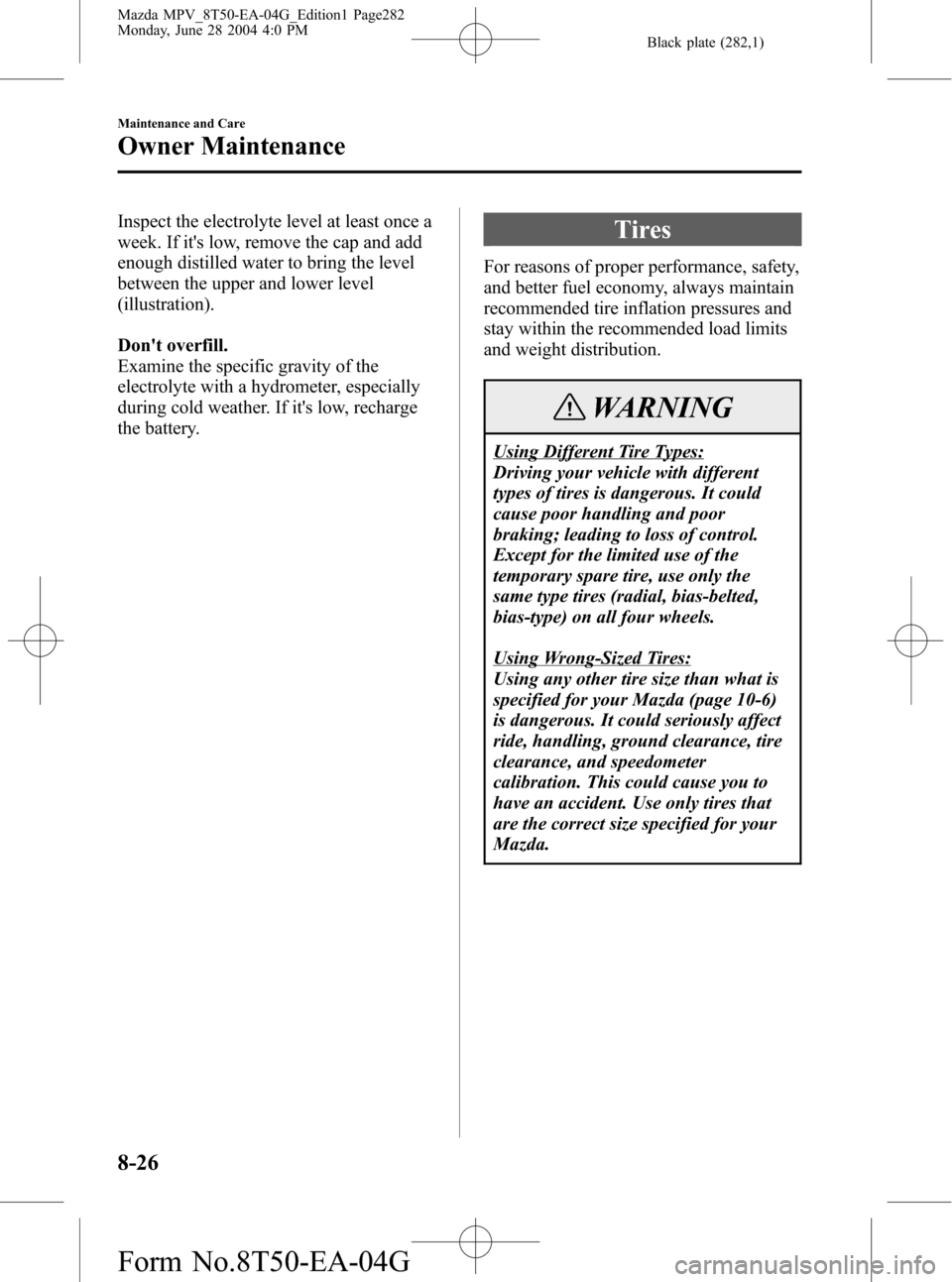warning MAZDA MODEL MPV 2005 Owners Manual (in English)
[x] Cancel search | Manufacturer: MAZDA, Model Year: 2005, Model line: MODEL MPV, Model: MAZDA MODEL MPV 2005Pages: 336, PDF Size: 5.31 MB
Page 267 of 336

Black plate (267,1)
The quality designation SL, or ILSAC
must be on the label.
5W-20
120 100 80
60 40
20
0 –20
50 40 30
20 10
0 –10
–20 –30
qInspecting Engine Oil Level
1. Be sure the vehicle is on a level
surface.
2. Warm up the engine to normal
operating temperature.
3. Turn it off and wait at least 5 minutes
for the oil to return to the oil pan.
4. Pull out the dipstick, wipe it clean, and
reinsert it fully.
Full
LowOK
5. Pull it out again and examine the level.
It's OK between MIN and MAX.
But if it's near or below MIN, add
enough oil to bring the level to MAX.
CAUTION
Don't add engine oil over MAX. This
may cause engine damage.
6. Make sure the O-ring on the dipstick is
positioned properly before reinserting
the dipstick.
qChanging Engine Oil and Filter
Change engine oil and filter according to
Scheduled Maintenance (page 8-3).
Please act responsibly―protect the
environment and take used oil to a
recycling facility. Ask your dealer or a
service station for information.
WARNING
Handling Used Engine Oil:
Continuous contact with used engine
oil is dangerous. It could cause skin
cancer. Always wash with soap and
water immediately after changing oil
and filter.
CAUTION
Remove any oil splatter from the
exhaust manifold, the exhaust pipe and
the shield. Oil left on these areas will
smoke when the engine is running.
Maintenance and Care
Owner Maintenance
8-11
Mazda MPV_8T50-EA-04G_Edition1 Page267
Monday, June 28 2004 4:0 PM
Form No.8T50-EA-04G
Page 268 of 336

Black plate (268,1)
Changing engine oil
WARNING
Checking or Changing Engine Oil:
Hot engine oil is dangerous. If the
engine has been running, the engine
oil becomes very hot. You could be
seriously burned. Don't check or
change the engine oil when the engine
is hot.
1. Warm up the engine for a few minutes
and turn it off. Remove the oil-filler
cap.
2. Remove the drain plug and drain the
oil into a suitable container.
3. Replace the plug tightly after the oil
has thoroughly drained.
4. Fill the engine with new oil to the
MAX mark on the dipstick.
5. Securely reinstall the oil-filler cap.
Tighten
Loosen
Drain plug
Forward
6. Start the engine and inspect around the
drain plug for leaks.
7. Turn it off and wait 5 minutes for the
oil to return to the oil pan.Check the oil level and fill to the MAX
mark if necessary.
Oil capacity (General reference only,
refer to Specifications section for
capacities.)
NOTE
lThe indicated engine oil capacities
are for general reference purposes
only. When adding or changing oil,
verify the engine oil level with the
oil dipstick.
lUse only specified engine oil (page
10-4).
Changing oil filter
Because you need a special tool to
retighten the filter, an Authorized Mazda
Dealer should do the work.
8-12
Maintenance and Care
Owner Maintenance
Mazda MPV_8T50-EA-04G_Edition1 Page268
Monday, June 28 2004 4:0 PM
Form No.8T50-EA-04G
Page 269 of 336

Black plate (269,1)
Engine Coolant
qInspecting Coolant Level
WARNING
Hot Engine:
A hot engine is dangerous. If the
engine has been running, parts of the
engine compartment can become very
hot. You could be burned. Carefully
inspect the engine coolant in the
coolant reservoir, but do not open it.
Do not use a match or live flame in the
engine compartment. DO NOT ADD
COOLANT WHEN THE ENGINE IS
HOT.
Cooling Fan and Engine
Inspection:
Inspecting the engine with the ignition
switch in the ON position is
dangerous. The cooling fan could turn
on unexpectedly even when the engine
isn't running. You could be seriously
injured by the fan. Turn the ignition
switch off and remove the key from the
ignition switch when you inspect the
engine.
Cooling System Cap:
When the engine and radiator are hot,
scalding coolant and steam may shoot
out under pressure and cause serious
injury. Don't remove the cooling
system cap when the engine and
radiator are hot.Inspect the antifreeze protection and
coolant level in the coolant reservoir at
least once a year―at the beginning of the
winter season―and before traveling
where temperatures may drop below
freezing.
Inspect the condition and connections of
all cooling system and heater hoses.
Replace any that are swollen or
deteriorated.
The coolant should be at full in the
radiator and between the F and L marks
on the coolant reservoir when the engine
is cool.
If it's at or near L, add enough coolant to
the coolant reservoir to provide freezing
and corrosion protection and to bring the
level to F.
CAUTION
Radiator coolant will damage paint.
Rinse it off quickly if spilled.
Do not overfill.
If new coolant is required frequently,
consult an Authorized Mazda Dealer.
Maintenance and Care
Owner Maintenance
8-13
Mazda MPV_8T50-EA-04G_Edition1 Page269
Monday, June 28 2004 4:0 PM
Form No.8T50-EA-04G
Page 270 of 336

Black plate (270,1)
qChanging Coolant (Without Rear
Heater)
Change coolant according to Scheduled
Maintenance (page 8-3).
CAUTION
lUse only soft (demineralized) water
in the coolant mixture. Water that
contains minerals will cut down on
the coolant's effectiveness.
lDon't add only water. Always add a
proper coolant mixture.
lThe engine has aluminum parts and
must be protected by an ethylene-
glycol-based coolant to prevent
corrosion and freezing.
lDO NOT USE alcohol or methanol
antifreeze. DO NOT MIX alcohol or
methanol with the coolant. This
could damage the cooling system.
lDon't use a solution that contains
more than 60 % antifreeze.
This would reduce effectiveness.
For mixture percentage:
ProtectionVolume
Antifreeze
solutionDemineralizedwater
Above–16°C (3°F) 35% 65%
Above–26°C (–15°F) 45% 55%
Above–40°C (–40°F) 55% 45%
To change coolant
WARNING
Removing the Cooling System Cap:
Removing the cooling system cap
while the engine is running or hot is
dangerous. This might lead to cooling
system and engine damage and could
result in serious injury from escaping
hot coolant or steam. Turn off the
engine and wait until it's cool. Even
then, be very careful when removing
the cap. Wrap a thick cloth around the
cap and slowly turn it
counterclockwise to the first stop.
Step back while the pressure escapes.
When you're sure all the pressure is
gone, press down on the cap―still
using a cloth―turn the cap, and
remove it.
1. Remove the cooling system cap.
F
L
Tighten Loosen
TightenLoosen
2. Only when the engine is cool, remove
the radiator drain plug and drain the
coolant into a suitable container.
Properly dispose of the used coolant.
3. Flush out the system with running
water.
8-14
Maintenance and Care
Owner Maintenance
Mazda MPV_8T50-EA-04G_Edition1 Page270
Monday, June 28 2004 4:0 PM
Form No.8T50-EA-04G
Page 272 of 336

Black plate (272,1)
qAdding Brake Fluid
WARNING
Spilled Brake Fluid:
Spilled brake fluid is dangerous. If it
gets in your eyes, they could be
seriously injured. If this happens,
immediately flush your eyes with water
and get medical attention. Brake fluid
spilled on a hot engine could cause a
fire. Be careful not to spill brake fluid
on yourself or on the engine.
Low Brake Fluid Levels:
Low brake fluid levels are dangerous.
Low levels could signal brake lining
wear or a brake system leak. Your
brakes could fail and cause an
accident. If you find a low fluid level,
have the brakes inspected.
If the fluid level is low, add fluid until it
reaches MAX.
Before adding fluid, thoroughly clean the
area around the cap.
CAUTION
lBrake fluid will damage painted
surfaces. If brake fluid does get on a
painted surface, wipe it off
immediately.
lUsing nonspecified brake fluids
(page 10-4) will damage the system.
Mixing different fluids will also
damage it.
If the brake system frequently
requires new fluid, consult an
Authorized Mazda Dealer.
Power Steering Fluid
qInspecting Power Steering Fluid
Level
CAUTION
To avoid damage to the power steering
pump, don't operate the vehicle for long
periods when the power steering fluid
level is low.
NOTE
Use specified power steering fluid
(page 10-4).
Inspect the fluid level in the reservoir at
each engine oil change with the engine off
and cold. Add fluid if necessary; it does
not require periodic changing.
The level must be kept between MIN and
MAX.
Visually examine the lines and hoses for
leaks and damage.
If new fluid is required frequently, consult
an Authorized Mazda Dealer.
8-16
Maintenance and Care
Owner Maintenance
Mazda MPV_8T50-EA-04G_Edition1 Page272
Monday, June 28 2004 4:0 PM
Form No.8T50-EA-04G
Page 273 of 336

Black plate (273,1)
Automatic Transaxle Fluid
(ATF)
qInspecting Automatic Transaxle
Fluid Level
The automatic transaxle fluid level should
be inspected regularly. Measure it as
described below.
The volume of fluid changes with the
temperature. Fluid must be checked at idle
without driving at normal operating
temperature.
CAUTION
lLow fluid level causes transaxle
slippage. Overfilling can cause
foaming, loss of fluid, and transaxle
malfunction.
lUse specified fluid (page 10-4). A
nonspecified fluid could result in
transaxle malfunction and failure.
1. Park on a level surface and set the
parking brake firmly.
2. Idle the engine about two minutes.
Push down on the brake pedal.
3. Move the shift lever through all ranges
and set it at P.
WARNING
Sudden Vehicle Movement:
Shifting the shift lever without first
depressing the brake pedal is
dangerous. The vehicle could move
suddenly and cause an accident.
Make sure the brake pedal is applied
before shifting the shift lever.
4. With the engine still idling, pull out the
dipstick, wipe it clean, and put it back.
5. Pull it out again.
The proper fluid level is marked on the
dipstick as follows.
A
B
Fluid hot scale A
When the vehicle has been driven and the
fluid is at normal operating temperature,
about 65°C (150°F), the level must be
between Full and Low.
Fluid cold scale B
When the engine has not been running
and the outside temperature is about 20°C
(70°F), the level must be between Full
and Low.
Maintenance and Care
Owner Maintenance
8-17
Mazda MPV_8T50-EA-04G_Edition1 Page273
Monday, June 28 2004 4:0 PM
Form No.8T50-EA-04G
Page 274 of 336

Black plate (274,1)
CAUTION
lUse the cold scale only as a
reference.
lIf outside temperature is lower than
about 20°C (70°F), start the engine
and inspect the fluid level after the
engine reaches operating
temperature.
lIf the vehicle has been driven for an
extended period at high speeds or in
city traffic in hot weather, inspect the
level only after stopping the engine
and allowing the fluid to cool for 30
minutes.
Fully insert the dipstick. When adding
fluid, inspect with the dipstick to make
sure it doesn't pass full.
NOTE
Inspect the fluid on both sides of the
dipstick in a well lit area for an accurate
reading.
Washer Fluid
qInspecting Washer Fluid Level
WARNING
Substitute Washer Fluid:
Using radiator antifreeze as washer
fluid is dangerous. If sprayed on the
windshield, it will dirty the windshield,
affect your visibility, and could result
in an accident. Use only windshield
washer fluid or plain water in the
reservoir.
Using Washer Fluid Without Anti-
freeze Protection in Cold Weather:
Operating your vehicle in
temperatures below 4 degrees C (40
degrees F) using washer fluid without
anti-freeze protection is dangerous as
it could cause impaired windshield
vision and result in an accident. In
cold weather, always use washer fluid
with anti-freeze protection.
NOTE
State or local regulations may restrict
the use of volatile organic compounds
(VOCs), which are commonly used as
anti-freeze agents in washer fluid. A
washer fluid with limited VOC content
should be used only if it provides
adequate freeze resistance for all
regions and climates in which the
vehicle will be operated.
8-18
Maintenance and Care
Owner Maintenance
Mazda MPV_8T50-EA-04G_Edition1 Page274
Monday, June 28 2004 4:0 PM
Form No.8T50-EA-04G
Page 280 of 336

Black plate (280,1)
Battery
WARNING
Battery-Related Lead Materials:
Battery posts, terminals and related accessories contain lead and lead compounds,
chemicals known to the State of California to cause cancer and reproductive harm.
Wash hands after handling.
Follow These Precautions Carefully:
To ensure safe and correct handling of the battery, read the following precautions
carefully before using the battery or inspecting it.
Eye Protection:
Working without eye protection is dangerous. Battery fluid contains SULFURIC
ACID which could cause blindness if splashed into your eyes. Also, hydrogen gas
produced during normal battery operation, could ignite and cause the battery to
explode. Always wear eye protection when working near the battery.
Spilled Battery Fluid:
Spilled battery fluid is dangerous.
Battery fluid contains SULFURIC ACID which could cause serious injuries if it gets
in eyes, skin or clothing. If this happens, immediately flush your eyes with water for
15 minutes or wash your skin thoroughly and get medical attention. Wear eye
protection and protective gloves to prevent contact with battery fluid.
Children and Batteries:
Allowing children to play near batteries is dangerous. Battery fluid could cause
serious injuries if it gets in the eyes or on the skin. Always keep batteries out of the
reach of children.
8-24
Maintenance and Care
Owner Maintenance
Mazda MPV_8T50-EA-04G_Edition1 Page280
Monday, June 28 2004 4:0 PM
Form No.8T50-EA-04G
Page 281 of 336

Black plate (281,1)
WARNING
Keep Flames Away:
Flames and sparks near open battery cells are dangerous. Hydrogen gas, produced
during normal battery operation, could ignite and cause the battery to explode. An
exploding battery can cause serious burns and injuries. Keep all flames including
cigarettes and sparks away from open battery cells. When working near a battery, do
not allow metal tools to contact the positive (
) or negative () terminal of the
battery. Do not allow the positive (
) terminal to contact the vehicle body.
Battery-Related Explosion:
Flames and sparks near open battery cells are dangerous. Hydrogen gas, produced
during normal battery operation, could ignite and cause the battery to explode. An
exploding battery can cause serious burns and injuries. Keep all flames, including
cigarettes, and sparks away from open battery cells.
qBattery Maintenance
To get the best service from a battery:
lKeep it securely mounted.
lKeep the top clean and dry.
lKeep terminals and connections clean,
tight, and coated with petroleum jelly
or terminal grease.
lRinse off spilled electrolyte
immediately with a solution of water
and baking soda.
lIf the vehicle will not be used for an
extended time, disconnect the battery
cables.
qInspecting Electrolyte Level
A low level of electrolyte fluid will cause
the battery to discharge quickly.
Upper level
Lower level
Maintenance and Care
Owner Maintenance
8-25
Mazda MPV_8T50-EA-04G_Edition1 Page281
Monday, June 28 2004 4:0 PM
Form No.8T50-EA-04G
Page 282 of 336

Black plate (282,1)
Inspect the electrolyte level at least once a
week. If it's low, remove the cap and add
enough distilled water to bring the level
between the upper and lower level
(illustration).
Don't overfill.
Examine the specific gravity of the
electrolyte with a hydrometer, especially
during cold weather. If it's low, recharge
the battery.Tires
For reasons of proper performance, safety,
and better fuel economy, always maintain
recommended tire inflation pressures and
stay within the recommended load limits
and weight distribution.
WARNING
Using Different Tire Types:
Driving your vehicle with different
types of tires is dangerous. It could
cause poor handling and poor
braking; leading to loss of control.
Except for the limited use of the
temporary spare tire, use only the
same type tires (radial, bias-belted,
bias-type) on all four wheels.
Using Wrong-Sized Tires:
Using any other tire size than what is
specified for your Mazda (page 10-6)
is dangerous. It could seriously affect
ride, handling, ground clearance, tire
clearance, and speedometer
calibration. This could cause you to
have an accident. Use only tires that
are the correct size specified for your
Mazda.
8-26
Maintenance and Care
Owner Maintenance
Mazda MPV_8T50-EA-04G_Edition1 Page282
Monday, June 28 2004 4:0 PM
Form No.8T50-EA-04G